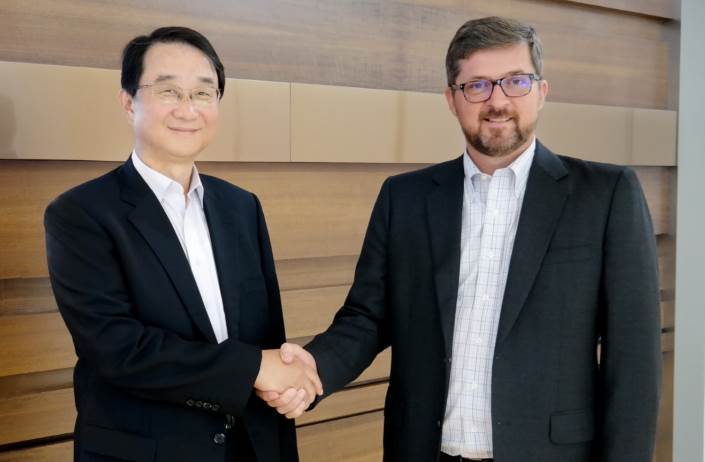The following article was contributed by Daryl Schoolar, Principal Analyst of Wireless Infrastructure for Ovum.
Right now, the entire telecommunications industry is preparing to usher in the era of 5G, which will surpass the current mainstream technology, 4G. Samsung Electronics has led in developing these innovative 4G technologies in the markets with the highest LTE penetration rates, such as the U.S., Korea, Japan and the UK. Now, the company is making preparations to lead the 5G era based on its innovative technology and previous success in implementing 4G.
In this interview, two of Samsung Network Business unit’s executives—Dr. Dongsoo Park, Executive Vice President and Head of Global Sales & Marketing Team, and Dr. Woojune Kim, Vice President, Next Generation Business Team—share how Samsung is working to do so.

Q. Please tell us a bit about Samsung Networks’ current business status and achievements in 4G LTE?
Dr. Park: Our success with 4G LTE has helped us to build a strong global networks business. We have led in the development of OFDMA (Orthogonal Frequency-Division Multiple Access) technologies and this experience has proved helpful in rolling out LTE solutions.
We have successfully deployed LTE technology in advanced markets including the U.S., Japan, the UK and Korea. To continue innovating and providing cutting-edge technologies, we have focused on mature markets with the highest mobile broadband adoption rates. We do, however, see additional opportunities in emerging markets that could also prove to be valuable.
Q. What is your strategy for entering new markets such as South Asia?
Dr. Park: We’re pursuing markets with high potential for large-scale LTE deployments. In these markets, we’re looking to target operators with similar needs to our existing customer base, like those that are seeking advanced, cutting-edge LTE solutions.
We would like to work in emerging markets to contribute to their digitalization through LTE, all the while cultivating long-term relationship with our customer-operators. Our partnership with Jio in India is a great example of this. We don’t want to put ourselves in a position where we are competing only on price. We’re trying to enter markets where we can lead in technological development with innovative solutions.
In cases where it is part of the operators’ strategy, 5G is a definite asset for creating our opportunities. The introduction of 5G, with its use of small cells mixed with macro cells and reliance on network virtualization, will lead to more open interfaces and make it easier to integrate multiple vendors.
Q. What business strategies will you use to stand out in a crowded field?
Dr. Park: When it comes to vendor differentiation, our strategy is to be “first to market” with leading edge technologies. Our collaboration with Korean operators has allowed us to lead the deployment of some of the most technologically advanced LTE networks in the world.
For instance, we set a number of precedents in our efforts to commercialize various LTE technologies. This includes developing VoLTE, multicarrier and LTE Smallcell in 2012, carrier aggregation in 2013, LTE Broadcast (eMBMS) in 2014, and tri-band carrier aggregation and virtualized core (NFV, vIMS/vEPC) in 2015. Furthermore, we expect to unveil LTE-Advanced Pro features early next year. These will enable users to reach 1-gigabit throughput using tri-band carrier aggregation, 256QAM and 4X4 MIMO.

Q. What is the background of Samsung’s Next Generation Business team?
Dr. Kim: Samsung has been working on 5G in different areas of the company (IC, devices, networks) for the last five years. But earlier this year, we found that 5G was accelerating faster than anticipated, so we had to increase our efforts accordingly. To do this, we had to consolidate all of our 5G projects into a single business unit. The result is the Next Generation Business team, which incorporates Samsung’s 5G development teams, along with the 5G strategy team.
Q. What are some of R&D-related preparations Samsung is making regarding 5G?
Dr. Kim: Samsung believes 5G is different than previous mobile standards. It is much more than just an interface for mobile devices. It is a completely new network architecture and it will be found in a much more diverse set of devices including consumer electronics and industrial devices.
Samsung has been developing 5G-related technologies since 2011. We have invested significant resources in 5G technologies like millimeter wave channel models and RF ICs. This includes RF key technologies for smaller chipsets, multi-cell handover with millimeter wave frequency and network virtualization technologies.
Q. What is your strategy for collaborating with the 5G industry?
Dr. Kim: The key starting point for our strategy to commercialize 5G is partnering with operators. Right now, we are developing Fixed Wireless Access (FWA) solutions and we expect to move on to mobile solutions. We are also collaborating with other ecosystem vendors, such as component vendors, to find ways to reduce the costs of 5G equipment and solutions.
We are even working with our competitors to create mutual standards on which we can build a set of 5G parameters. These parameters will help operators understand what to expect from 5G. In addition, we have started to work with third-parties to ensure that video, IoT and other applications run properly across 5G networks.
Q. How is Samsung planning to differentiate itself when it comes to 5G?
Dr. Kim: Internally, we are proactively bringing together as many business units as possible to usher in this new era of telecommunications. For example, to introduce millimeter wave the network will require a new type of base station that is small, visually attractive, cost-effective and has the ability to run on low power. This requires Samsung not only to leverage engineering expertise in the network business to build the radio, but also to bring in resources from our consumer electronics business to create something that will be aesthetically pleasing.
Q. When will the 5G commercialization take place?
Dr. Kim: We think we will see some initial commercial networks based on 5G by the end of 2017 or early in 2018. We are expecting targeted use case-driven deployments initially, as opposed to all-encompassing nationwide rollouts.
We’ll also see that 5G won’t be as mobile-centric as we might have considered it to be previously. Fixed wireless, IoT and mission critical communications don’t always have the same broad coverage requirements as found in our traditional mobile communications networks.
5G, therefore, will serve much more than mobile devices and networks, as it won’t be required to have the same universal coverage. Instead, 5G will be deployed in more select areas for specific 5G aspects, such as high bandwidth or low latency, with LTE filling in coverage gaps.
Q. After launching 5G FWA commercially, what steps will Samsung take to initiate full 5G mobility?
Dr. Kim: Once the operators implement Fixed Wireless Access (FWA), they can then add mobility. Put simply, 5G FWA might be described as a “wireless fiber to the home” which is considered one of initial 5G use cases. 5G mobility is expected to be available around 2020. Until then, we will satisfy the current market needs of 5G FWA starting in 2017.
Q. What is the biggest misunderstanding that mobile operators have about Samsung Networks?
Dr. Park: Some mobile operators attribute the success of our networks business solely to our customer-operators in Korea. However, Samsung has been committed to mobile network development for more than 35 years, and actively contributed to advancing connectivity capabilities in a number of markets.
Having Korea as our home base affords us an incredible opportunity to commercialize the latest technology, which are reinforced by our current presence in the U.S., Japan, Europe, Southeast Asia, the Middle East and Russia. Our recent collaboration with Jio India further promotes Samsung’s firm commitment to the infrastructure business.







